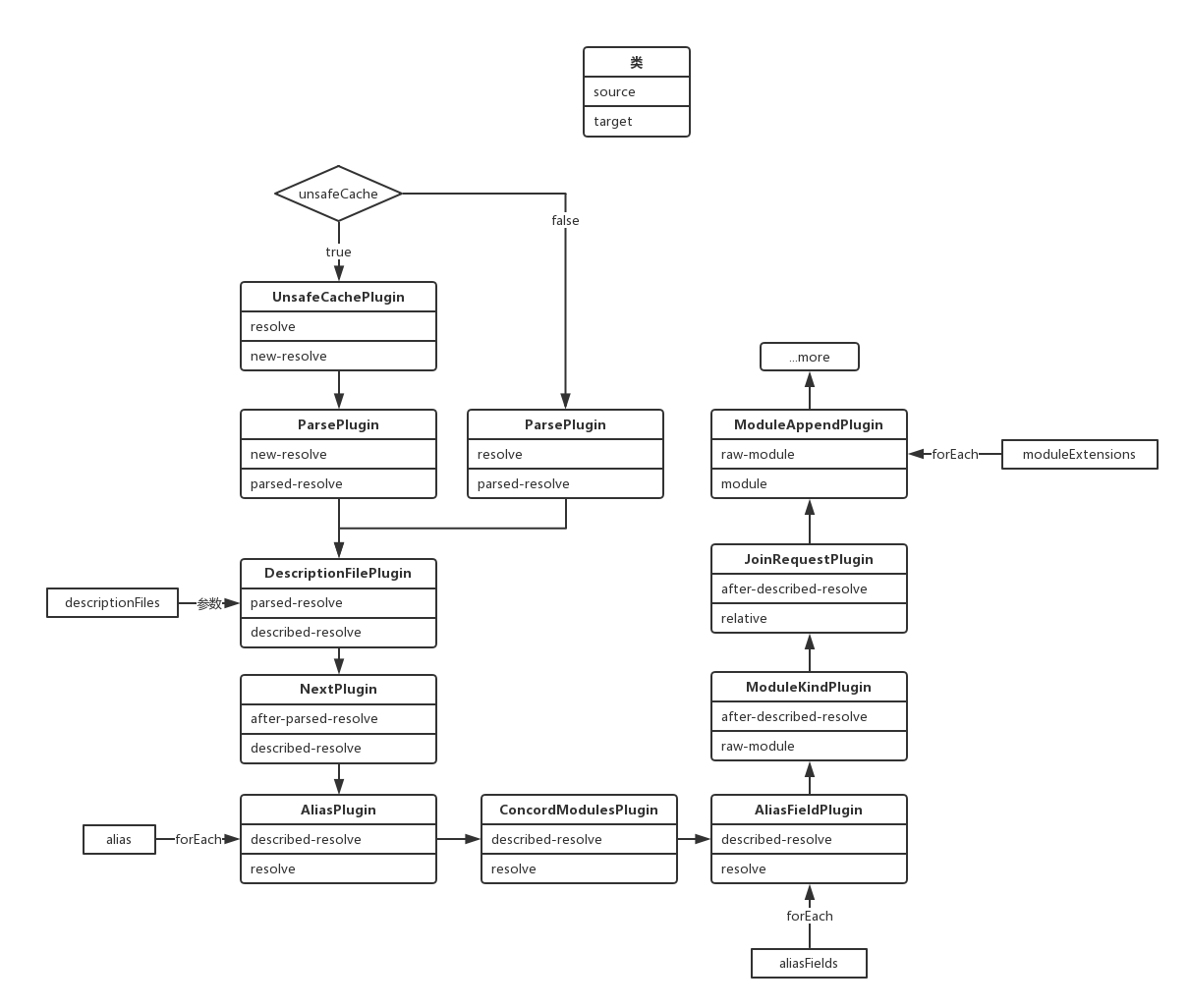原本该在过WebpackOptionsApply时讲解这个方法的,但是当时一不小心过掉了,所以在这里补上。
compiler.resolvers
该对象的三个方法均在WebpackOptionsApply中生成,代码如下:
compiler.resolvers.normal = ResolverFactory.createResolver(Object.assign({ fileSystem: compiler.inputFileSystem }, options.resolve)); compiler.resolvers.context = ResolverFactory.createResolver(Object.assign({ fileSystem: compiler.inputFileSystem, resolveToContext: true }, options.resolve)); compiler.resolvers.loader = ResolverFactory.createResolver(Object.assign({ fileSystem: compiler.inputFileSystem }, options.resolveLoader));
由于调用的是一个工厂函数,所以用normal作为示例讲解。
/* "resolve": { "unsafeCache": true, "modules": ["node_modules"], "extensions": [".js", ".json"], "mainFiles": ["index"], "aliasFields": ["browser"], "mainFields": ["browser", "module", "main"], "cacheWithContext": false }, */ compiler.resolvers.normal = ResolverFactory.createResolver(Object.assign({ fileSystem: compiler.inputFileSystem }, options.resolve));
其中参数中的resolve取了默认值,如注释所示。
ResolveFactory.createResolver
这个方法比较有意思,一块一块的来看源码,所有注释保留英文原文更好理解:
exports.createResolver = function(options) { //// OPTIONS //// // A list of directories to resolve modules from, can be absolute path or folder name // 模块文件夹的目录或者文件夹名称 var modules = options.modules || ["node_modules"]; // A list of description files to read from // 描述配置文件名 var descriptionFiles = options.descriptionFiles || ["package.json"]; // A list of additional resolve plugins which should be applied // The slice is there to create a copy, because otherwise pushing into plugins // changes the original options.plugins array, causing duplicate plugins // 额外的插件 var plugins = (options.plugins && options.plugins.slice()) || []; // A list of main fields in description files // 不知道干啥的 var mainFields = options.mainFields || ["main"]; // A list of alias fields in description files // 不知道干啥的 var aliasFields = options.aliasFields || []; // A list of main files in directories // 模块主入口文件名 var mainFiles = options.mainFiles || ["index"]; // A list of extensions which should be tried for files // 默认的文件扩展名 var extensions = options.extensions || [".js", ".json", ".node"]; // Enforce that a extension from extensions must be used var enforceExtension = options.enforceExtension || false; // A list of module extensions which should be tried for modules var moduleExtensions = options.moduleExtensions || []; // Enforce that a extension from moduleExtensions must be used var enforceModuleExtension = options.enforceModuleExtension || false; // A list of module alias configurations or an object which maps key to value // 别名 var alias = options.alias || []; // ...还有一些其他奇奇怪怪的属性 //// options processing //// // ...第二部分 };
这一步是包装参数,主要看注释,基本上对resolve参数下的各个key都做了解释,有一些实在不知道干啥用的就省略了。
基本上可能会自定义的大概只有extensions、alias两个属性。
下面来看第二部分:
exports.createResolver = function(options) { //// OPTIONS //// // ...第一部分 //// options processing //// if (!resolver) { // useSyncFileSystemCalls默认为undefined resolver = new Resolver(useSyncFileSystemCalls ? new SyncAsyncFileSystemDecorator(fileSystem) : fileSystem); } // 数组包装 extensions = [].concat(extensions); moduleExtensions = [].concat(moduleExtensions); // 返回[['node_modules']] modules = mergeFilteredToArray([].concat(modules), function(item) { return !isAbsolutePath(item); }); // 不懂这个参数干啥的 // 返回一个对象数组 mainFields = mainFields.map(function(item) { if (typeof item === "string") { item = { name: item, forceRelative: true }; } return item; }); // 处理别名 if (typeof alias === "object" && !Array.isArray(alias)) { /**/ } // 不知道什么东西 if (unsafeCache && typeof unsafeCache !== "object") { unsafeCache = {}; } //// pipeline //// // ...第三部分 };
这一部分是处理参数,resolver是最后返回的对象,到调用的时候再细看。
几个参数由于不太懂什么作用,处理方法也很简单,就不做解释,这里看一下alias别名的处理:
/* alias: { 'vue$': 'vue/dist/vue.esm.js', '@': '../src' } */ /* alias:[ { name: 'vue', onlyModule: true, alias: 'vue/dist/vue.esm.js' }, { name: '@', onlyModule: false, alias: '../src' } ] */ if (typeof alias === "object" && !Array.isArray(alias)) { alias = Object.keys(alias).map(function(key) { var onlyModule = false; var obj = alias[key]; // 测试是否以$结尾 if (/$$/.test(key)) { onlyModule = true; key = key.substr(0, key.length - 1); } // alias的值是否为字符串 if (typeof obj === "string") { obj = { alias: obj }; } obj = Object.assign({ name: key, onlyModule: onlyModule }, obj); return obj; }); }
这里以vue-cli为例,展示了转换后的alias,看注释就OK了。
第三部分有点恶心,源码大概是这样子的:
exports.createResolver = function(options) { //// OPTIONS //// // ...第一部分 //// options processing //// // ...第二部分 //// pipeline //// // resolve if (unsafeCache) { plugins.push(new UnsafeCachePlugin("resolve", cachePredicate, unsafeCache, cacheWithContext, "new-resolve")); plugins.push(new ParsePlugin("new-resolve", "parsed-resolve")); } else { plugins.push(new ParsePlugin("resolve", "parsed-resolve")); } // ...无穷多的if + plugins.push(...) //// RESOLVER //// plugins.forEach(function(plugin) { resolver.apply(plugin); }); return resolver; };
虽然有非常多的plugin,但是内部处理形式大同小异。所以就一个常用参数作为例子,比如说:
// described-resolve alias.forEach(function(item) { plugins.push(new AliasPlugin("described-resolve", item, "resolve")); });
简要的看一下内部,这里的alias就是上面转换后的对象数组。
class AliasPlugin { constructor(source, options, target) { this.source = source; this.name = options.name; this.alias = options.alias; this.onlyModule = options.onlyModule; this.target = target; } apply(resolver) { var target = this.target; var name = this.name; var alias = this.alias; var onlyModule = this.onlyModule; resolver.plugin(this.source, function(request, callback) { /**/ }); } }
第三部分所有的plugins都是这样的形式。
1、构造函数仅仅获取并初始化值
2、有一个apply方法,接受一个resolver参数
3、注入参数source的事件流
4、在source事件流最后,target参数会在resolver.doResolve方法中被调用,这里省略了代码
在函数的最后,可以看到有一个这样的调用:
plugins.forEach(function(plugin) { resolver.apply(plugin); });
这里就是依次执行所有plugin的apply方法,传入resolver作为参数。
所有的插件plugin流程以示意图的形式给出,这里就不一一分析了。



注入完所有的事件流后,返回这个resolver对象,也就是compiler.resolvers.normal(loader、context)。